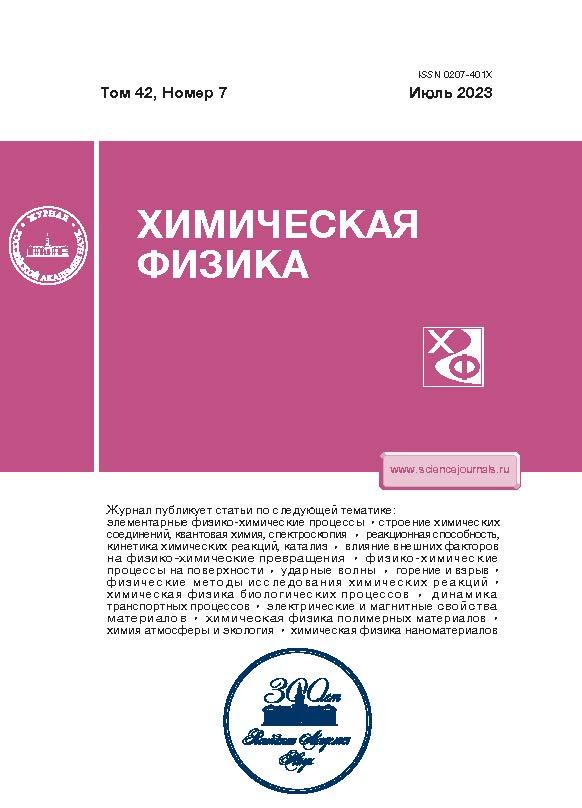Specific Features of the Decay Kinetics of an Excited Singlet State Into a Pair of Triplet Excitons In Rubrene Crystals
- Авторлар: Shushin A.I.1, Umanski S.Y.1, Chaikina Y.A.1
-
Мекемелер:
- Semenov Federal Research Center for Chemical Physics, Russian Academy of Sciences
- Шығарылым: Том 42, № 7 (2023)
- Беттер: 86-94
- Бөлім: XXXIV СИМПОЗИУМ “СОВРЕМЕННАЯ ХИМИЧЕСКАЯ ФИЗИКА” (СЕНТЯБРЬ 2022 г., ТУАПСЕ)
- URL: https://cijournal.ru/0207-401X/article/view/674856
- DOI: https://doi.org/10.31857/S0207401X23070178
- EDN: https://elibrary.ru/YGNLPM
- ID: 674856
Дәйексөз келтіру
Аннотация
In this study, the specific features of the kinetics of singlet fission (SF)—i.e., spontaneous splitting of the excited singlet state into a pair of triplet (T) excitons (TT-pair)—in anisotropic molecular crystals are analyzed in detail. These features are known to be primarily determined by the TT-annihilation of the created TT-pairs (migrating in the crystals). In our analysis, the kinetics of annihilation-affected SF processes is described in the two-state model (TSM), in which the interaction of migrating T-excitons is associated with transitions between two kinetic states of TT-pairs: [TT]-state of coupled TT-pairs and [T+T]-state of freely migrating T-excitons. The TSM makes it possible to represent the effects of migration and interaction on SF-kinetics in terms of the lattice Green’s functions, for which the analytical formulas are obtained in this study. The TSM is applied to the analysis of SF-kinetics in the rubrene single crystals recently measured in a wide time range. The analysis provides detailed information on some characteristic kinetic properties of SF processes in anisotropic crystals. It is shown, for example, that the formation of the [TT]-state in the SF process results in some distortion of the shape of the SF kinetic dependence at short times (of the order of the primary-stage time of SF kinetics). Is also demonstrated that the anisotropy of T-exciton migration manifests itself in some characteristic features of SF kinetics at long times.
Негізгі сөздер
Авторлар туралы
A. Shushin
Semenov Federal Research Center for Chemical Physics, Russian Academy of Sciences
Email: shushin@chph.ras.ru
Moscow, Russia
S. Umanski
Semenov Federal Research Center for Chemical Physics, Russian Academy of Sciences
Email: shushin@chph.ras.ru
Moscow, Russia
Yu. Chaikina
Semenov Federal Research Center for Chemical Physics, Russian Academy of Sciences
Хат алмасуға жауапты Автор.
Email: shushin@chph.ras.ru
Moscow, Russia
Әдебиет тізімі
- Smith M.B., Michl J. // Annu. Rev. Phys. Chem. 2013. V. 64. P. 361.
- Casanova D. // Chem. Rev. 2018. V. 118. P. 7164; https://doi.org/10.1021/acs.chemrev.7b00601
- Miyata K., Conrad-Burton F. S., Geyer F. L. et al. // Ibid. 2019. V. 84. P. 4261; https://doi.org/10.1021/acs.chemrev.8b00572
- Merrifield R.E. // J. Chem. Phys. 1968. V. 48. P. 4318; https://doi.org/10.1063/1.1669777
- Suna A. // Phys. Rev. B. 1970. V. 1. P. 1716; https://doi.org/10.1103/PhysRevB.1.1716
- Shushin A.I. // J. Chem. Phys. 2022. V. 156. P. 074703; https://doi.org/10.1063/5.0078158
- Tarasov V.V., Zoriniants G.E., Shushin A.I. et al. // Chem. Phys. Lett. 1997. V. 267. P. 58; https://doi.org/10.1016/S0009-2614(97)00056-0
- Ветчинкин А.С., Уманский С.Я., Чайкина Ю.А. и др. // Хим. физика. 2022. Т. 41. № 9. С. 72; https://doi.org/10.31857/S0207401X22090102
- Ryansnyanskiy A., Biaggio I. // Phys. Rev. B. 2011. V. 84. P. 193203; https://doi.org/10.1103/PhysRevB.84.193203
- Barhoumi T., Monge J.L., Mejatty M. et al. // Eur. Phys. J. B. 2007. V. 59. P. 167.
- Piland G.B., Burdett J.J., Kurunthu D. et al. // J. Phys. Chem. 2013. V. 117. P. 1224; https://doi.org/10.1021/jp309286v
- Шушин А.И. // Хим. физика. 2017. Т. 36. № 11. С. 17; https://doi.org/10.7868/S0207401X17110085
- Pilland G.B., Burdett J.J., Dillon R.J. et al. // J. Phys. Chem. Lett. 2014. V. 5. P. 2312; https://doi.org/10.1021/jz500676c
- Steiner U.E., Ulrich T. // Chem. Rev. 1989. V. 89. P. 514; https://doi.org/10.1021/cr00091a003
- Blum K. Density Matrix Theory and Applications. N.Y.: Plenum Press, 1981.
- Shushin A.I. // Chem. Phys. Lett. 1985. V. 118. P. 197; https://doi.org/10.1016/0009-2614(85)85297-0
- Shushin A.I. // J. Chem. Phys. 1991. V. 95. P. 3657; https://doi.org/10.1063/1.460817
- Shushin A.I. // Ibid. 1992. V. 97. P. 1954; https://doi.org/10.1063/1.463132
- Wolf E.A., Biaggio I. // Phys. Rev. B. 2021. V. 103. P. L201201; https://doi.org/10.1103/PhysRevB.103.L201201
- Shushin A.I. // J. Chem. Phys. 2019. V. 151. P. 034103; https://doi.org/10.1063/1.5099667
- Shushin A.I. // Chem. Phys. Lett. 2017. V. 678. P. 283; https://doi.org/10.1016/j.cplett.2017.04.068
- Лаврентьев M.A., Шабат Б.В. Методы теории функций комплексного переменного. М.: Наука, 1973.
- Buchachenko A.L. // Russ. J. Phys. Chem. B. 2022. V. 16. P. 9; https://doi.org/10.1134/S1990793122010031
- Buchachenko A.L., Kuznetsov D.A. // Russ. J. Phys. Chem. B. 2021. V. 15. P. 1; https://doi.org/10.1134/S1990793121010024
- Лундин А.А., Зобов В.Е. // Хим. физика. 2021. Т. 40. № 9. С. 41; https://doi.org/10.31857/S0207401X21090077
Қосымша файлдар










